How to memorize common trigonometric angles
This post is not going to be about how to use your fingers or sing a song to memorize the common trigonometric angles.
Instead of having your education based on if you could sing a song or not let's instead deduce this common angles based on what information you do know. By the way, this is very much the same way that your memory stores away information.
All of this starts with a right angle that can be represented by the following triangle.
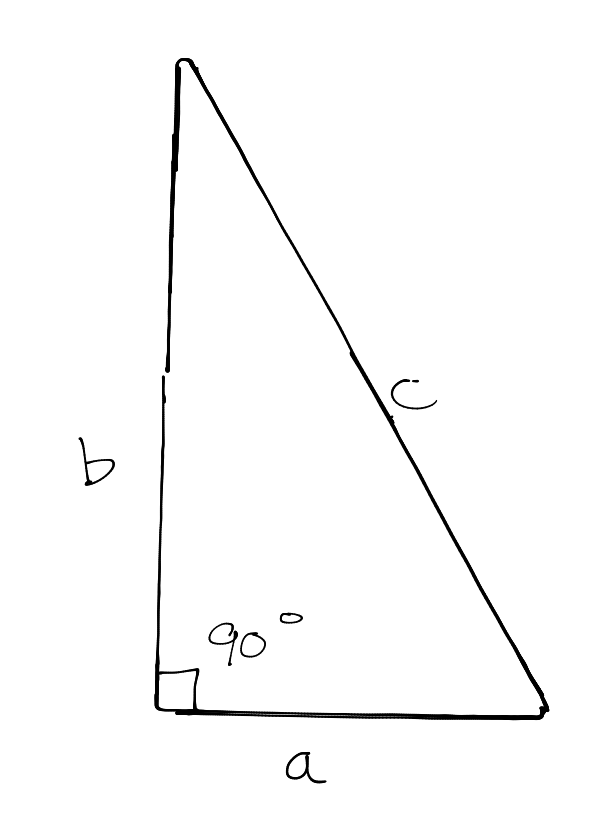
$${ a }^{ 2 }+{ b }^{ 2 }={ c }^{ 2 }$$
You can now find each side of the triangle just as long as you know two sides of the triangle based on this equation.
Do you remember the basic trig functions? If not here is a review of them sin(x) cos(x) tan(x).
If you are still having a hard time remembering each of this functions take a second and review: How to Remember Sin(x), Cos(x), Tan(x)?
Let's start with the most common angles.
$0$ radians. How would this triangle look like? This is a tricky question. If you think about it the triangle would end up being just a flat line across the $0$ mark on the plane.

I'm letting $a=1$ just to make the math easier for us. You will then need to find the $sin(0)$, $cos(0)$, and $tan(0)$.
$$sin(0)=0$$ $$cos(0)=1$$ $$tan(0)=0$$
Here is where things get interesting. If you let the angle be created from the left side of the line you would create a positive angle and you would be able to find $sin(0)$, $tan(0)$ but since no angle can be created at $0$ radians you are left with just $cos(0)$ which is just $1$.
$\frac { \pi }{ 6 }$ radians. How would this triangle look like? If you think about it the triangle would end up being just $\frac { \pi }{ 6 }$ radians away from the initial side.
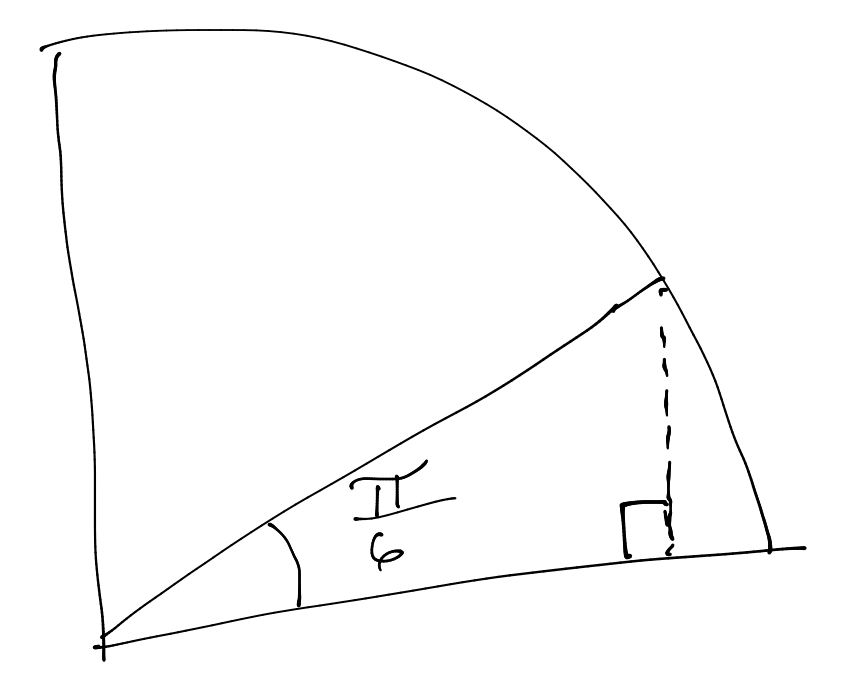
Based on this information you can now find the rest of the parts of the triangle.
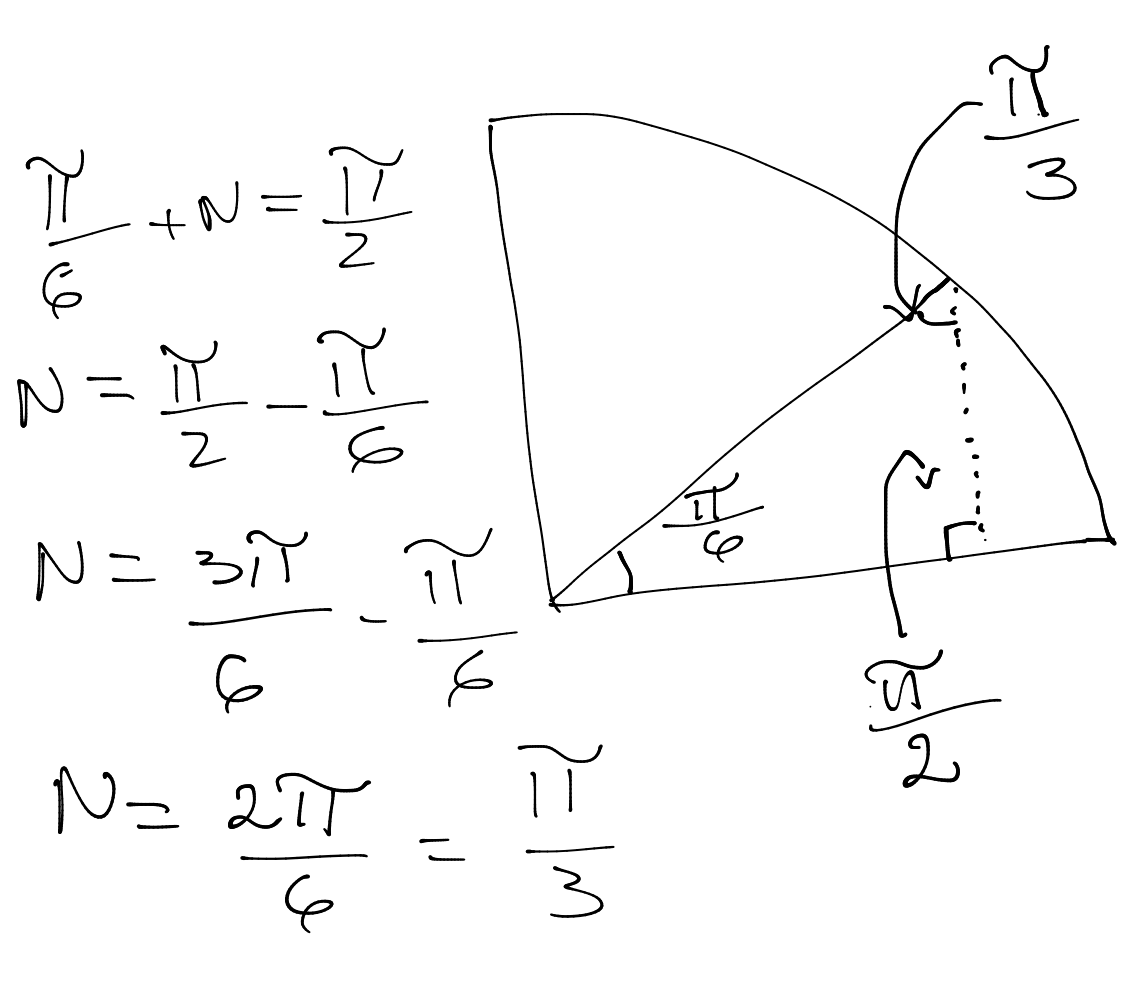
All of this is great! You now know all of the angles that compose this triangle. The problem becomes how do you find the $sin(\frac { \pi }{ 6 })$, $cos(\frac { \pi }{ 6 })$, and $tan(\frac { \pi }{ 6 })$ of this triangle?
Because you don't know any of the sides of this triangle and you can't assume any of the sides of the triangle let's start with a simpler isosceles triangle of the same length.
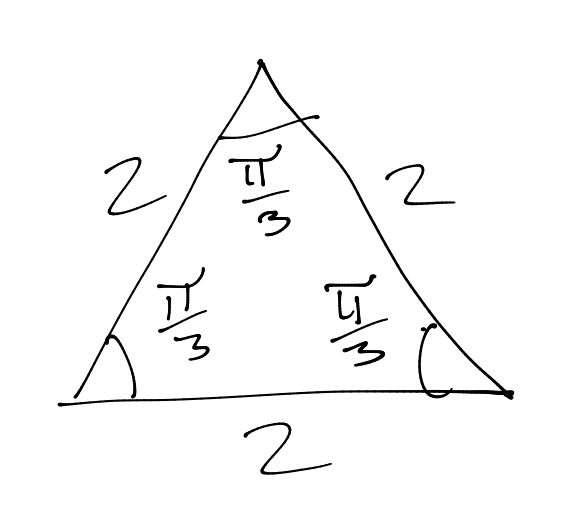
If you now take this very same triangle and cut it up in half you would end up with this triangle.
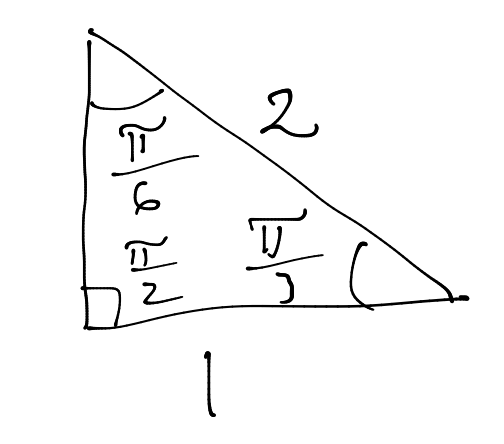
The only piece missing from this triangle is the rise of the triangle which you can find by using the Pythagorean theorem.
$$1^{ 2 }+{ b }^{ 2 }={ 2 }^{ 2 }$$ $$1+{ b }^{ 2 }=4$$ $${ b }^{ 2 }=4-1$$ $${ b }=\sqrt { 3 }$$
You now know all three pieces of the triangle you can complete the triangle with the following labels.
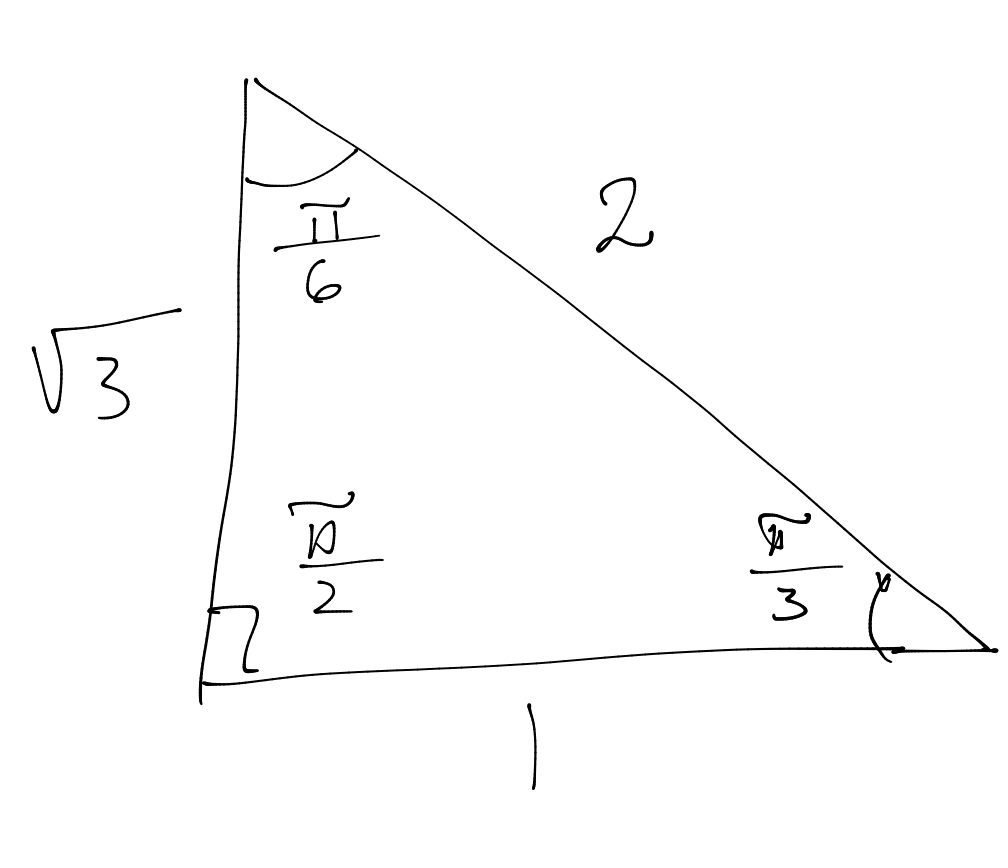
If you pay close attention to the triangle above you can now define the $sin$, $cos$, and $tan$ values for $\frac { \pi }{ 6 }$ and $\frac { \pi }{ 3 }$ radians.
Let's first find the values for $\frac { \pi }{ 6 }$.
$$sin(\frac { \pi }{ 6 })=\frac { 1 }{ 2 }$$ $$cos(\frac { \pi }{ 6 })=\frac { \sqrt { 3 } }{ 2 }$$ $$tan(\frac { \pi }{ 6 })=\frac { \sqrt { 3 } }{ 3 }$$
Let's find the values for $\frac { \pi }{ 3 }$.
$$sin(\frac { \pi }{ 3 })=\frac { \sqrt { 3 } }{ 2 }$$ $$cos(\frac { \pi }{ 3 })=\frac { 1 }{ 2 }$$ $$tan(\frac { \pi }{ 3 })=\sqrt { 3 }$$
The last two remaining angles to take a look at are $\frac { \pi }{ 2 }$ and $\frac { \pi }{ 4 }$ if I was to draw this triangle how would it look like?
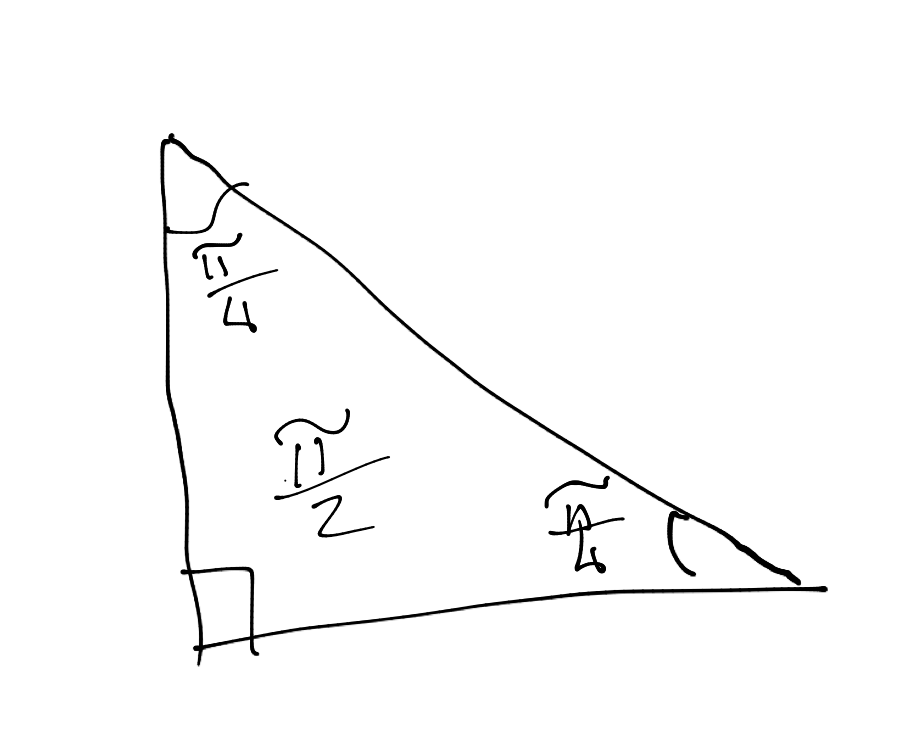
Let's now find each of the sides in the triangle.
$${ a }^{ 2 }+{ b }^{ 2 }={ c }^{ 2 }$$ $${ 1 }^{ 2 }+{ 1 }^{ 2 }={ c }^{ 2 }$$ $$2={ c }^{ 2 }$$ $$c=\sqrt { 2 }$$
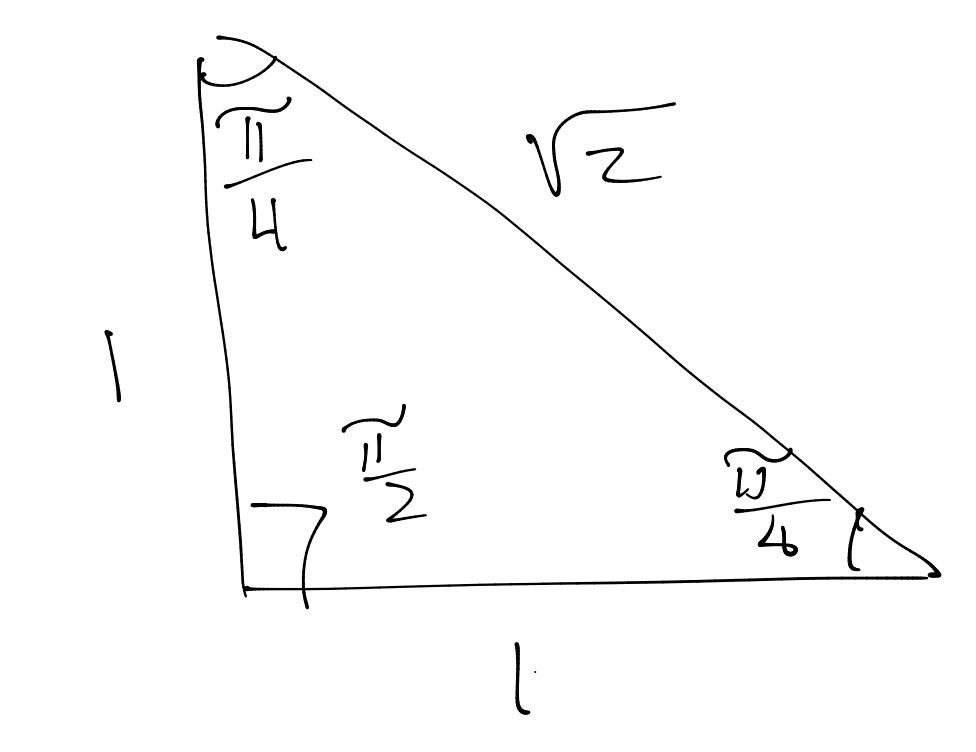
If you pay close attention to the triangle above you can now define the $sin$, $cos$, and $tan$ values for $\frac { \pi }{ 4 }$ and $\frac { \pi }{ 2 }$ radians.
Let's first find the values for $\frac { \pi }{ 4 }$.
$$sin(\frac { \pi }{ 4 })=\frac { \sqrt { 2 } }{ 2 }$$ $$cos(\frac { \pi }{ 4 })=\frac { \sqrt { 2 } }{ 2 }$$ $$tan(\frac { \pi }{ 4 })=1$$
Next up is $\frac { \pi }{ 2 }$
$$sin(\frac { \pi }{ 2 })=1$$ $$cos(\frac { \pi }{ 2 })=0$$ $$tan(\frac { \pi }{ 2 })=undefined$$
There you have it. You have completed 0, $\frac { \pi }{ 6 }$, $\frac { \pi }{ 4 }$, $\frac { \pi }{ 3 }$, and $\frac { \pi }{ 2 }$.